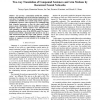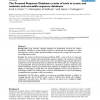10602 search results - page 70 / 2121 » Weakly Useful Sequences |
CANDC
2000
ACM
13 years 9 months ago
2000
ACM
A new statistical model for DNA considers a sequence to be a mixture of regions with little structure and regions that are approximate repeats of other subsequences, i.e. instance...
IROS
2007
IEEE
14 years 3 months ago
2007
IEEE
- We present a connectionist model that combines motions and language based on the behavioral experiences of a real robot. Two models of recurrent neural network with parametric bi...
BMCBI
2007
13 years 9 months ago
2007
Background: Large molecular sequence databases are fundamental resources for modern bioscientists. Whether for project-specific purposes or sharing data with colleagues, it is oft...
BMCBI
2010
13 years 9 months ago
2010
Background: The investigation of plant genome structure and evolution requires comprehensive characterization of repetitive sequences that make up the majority of higher plant nuc...
BMCBI
2008
13 years 9 months ago
2008
Background: Genome survey sequences (GSS) offer a preliminary global view of a genome since, unlike ESTs, they cover coding as well as non-coding DNA and include repetitive region...


